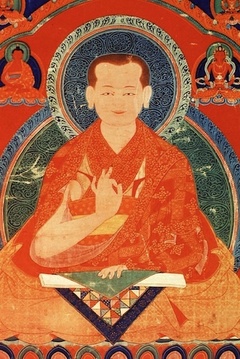Elucidating the Essence
Elucidating the Essence of the Instructions for Entering the Three Gateways to Liberation
by Rongtön Sheja Kunrig
Homage to the guru and the supreme deity!
With wisdom, like the maṇḍala of the sun, maker of the day,
You illuminate all knowable things without exception,
And with your immeasurable compassion, you care for beings,
O sun-like lord of sages, at the jewel of my crown I honour you.
You who banish entirely ignorance's gloom,
While shining the light of genuine meaning,
Guiders of beings, unsurpassed in your activity,
Hosts of buddhas' heirs, billions in number, to you I offer praise.
A message finely communicated throughout the excellent teachings,
Instructions for meditating on liberation's three gateways,
Now that I have understood them well, I shall, for others' sake,
Make them perfectly clear, using the voice of reasoning.
The three meditations (samādhi) to be cultivated are: 1) meditation on emptiness; 2) meditation on the absence of characteristics; 3) meditation on the wishless.
1. Meditation on Emptiness
We must arrive at a definitive understanding of the ground, which is emptiness, because it is by realizing the emptiness of the ground that we can counteract the ignorance of clinging to things as real. And this, in turn, will put an end to saṃsāra. As the Seventy Verses on Emptiness says:
Any thoughts of genuine reality
The Teacher has declared to be ignorance.[1]
Thus, since clinging to things as real is explained as ignorance, it follows that we must realize emptiness as the antidote to clinging to things as real. That is why the Root Verses on Wisdom says:
The cessation of ignorance comes about
Through meditating on the very nature with wisdom.[2]
2. Meditation on the Absence of Characteristics
The absence of characteristics can be explained in relation to both the truth of cessation and the truth of the path. This is because the truth of cessation is the very essence of the absence of characteristics, whereas the truth of the path consists of methods for eliminating thoughts that involve characteristics.
Meditation on the eight aspects of the truths of cessation and the path is explained as “meditation on the absence of characteristics” because it is meditation with a focus on the absence of signs. It is therefore described as “meditation on the absence of characteristics” in terms of its objects of focus.
Meditation on six aspects—two aspects of the truth of suffering and four aspects of the truth of origination—is explained as the meditative absorption on the absence of the wishless, because the focus is on the phenomena of saṃsāra, which are not things one aspires towards.
Meditating on impermanence and suffering, which are aspects of the truth of suffering, is necessary in order to turn the mind away from the present life and develop an attitude of concern for future lives. The meditation on the eight aspects of the truths of cessation and the path is necessary because we must see the benefits of liberation and understand the necessity of applying the means to attain it.
Meditating on the two aspects of the truth of suffering and the four aspects of the truth of origination corresponds to understanding saṃsāra's defects because it brings about an attitude of wishing to escape from saṃsāra. As Dampa Gyagar[3] said:
Unless you can feel revulsion for the things of saṃsāra,
Even knowing the entire Tripiṭika is of no benefit.
In short, the meditation on emptiness brings realization of emptiness as an antidote to clinging to the ground as real, and the meditation on the absence of characteristics cuts through any clinging to the characteristics of the path. These two illustrate the means of eliminating conceptual imputations (sgro 'dogs) towards objects and the means of eliminating conceptual imputations towards the path.
3. Meditation on the Wishless
The meditation on the wishless brings an understanding of the faults of saṃsāra and an attitude of determination to be free.
Conclusion
These three meditations serve as antidotes to any clinging to characteristics in the ground, path and fruition, and are therefore described as an antidotal approach. It is because this eliminates any imputations in meditative absorption that noble beings have described it as “signless samādhi”. And it is because it brings about a realization of how the ground is emptiness, the path is without characteristics, and the phenomena of saṃsāra are beyond aspiration, that it is divided into three gateways to liberation.
Summarizing Dharma's eighty-four thousand sections,
I have here clarified, without error, the stages of cultivating,
The threefold samādhi—through the virtue of this,
May all beings swiftly attain awakening!
This text, entitled “Elucidating the Essence of the Instructions for Entering the Three Gateways to Liberation”, was written by the great omniscient Rongtön at the monastery of Pal Nālendra on an auspicious day during the month of Saga Dawa in the Namjung year (i.e., the earth-dragon, 1448).
| Translated by Adam Pearcey, 2016.
Bibliography
Tibetan sources
shes bya kun rig. "rnam thar sgo gsum la 'jug pa'i man ngag snying po rab gsal." In gsung 'bum/_shes bya kun rig. 10 vols. skye dgu mdo: gangs ljongs rig rgyan gsung rab par khang, 2004. (BDRC W28942). Vol. 1: 161–164
Secondary sources
Lindtner, Chr. Master of Wisdom: Writings of the Buddhist Master Nāgārjuna. Berkeley: Dharma Publishing, 1997.
Siderits, Mark & Katsura, Shōryū, Nāgārjuna's Middle Way: The Mūlamadhyamakakārikā, Boston: Wisdom Publications, 2013
Notes
-
Śūnyats̄aptati, 64 bc ↩
-
Mūlamadhyamaka-kārikā, XXVI, 11 cd. Interpretations (and translations) of these key lines vary considerably. The translation here partially derives from a reading of the Sanskrit, i.e., avidyāyā nirodhas tu jñānasyāsyaiva bhāvanāt// ↩
-
Dam pa rgya gar, the Indian Saint, is another name for Padampa Sangye (Pha dam pa sangs rgyas, d. 1117?). ↩
